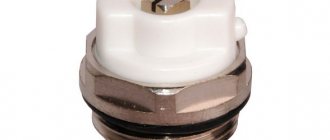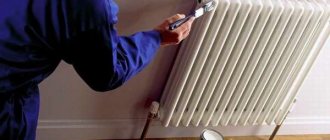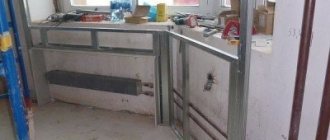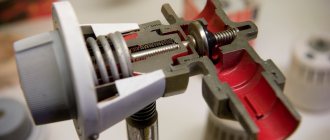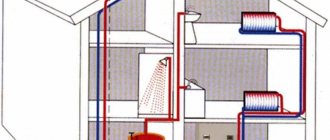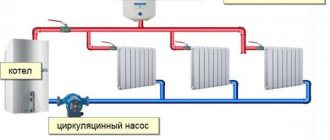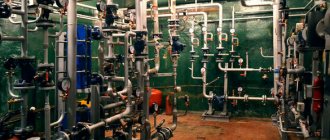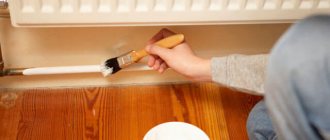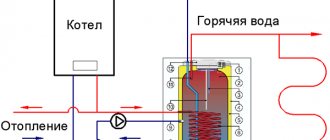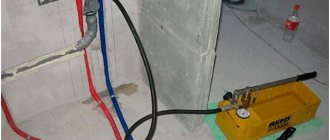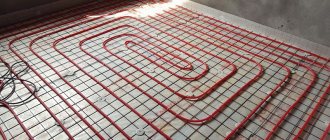Every owner of a private house or apartment with water heating should know how to bleed air from a heating radiator. The thing is that the accumulated air in the radiator becomes an insurmountable obstacle and blocks the flow of coolant.
As a result, the heating radiator ceases to function fully, that is, all or part of its surface ceases to heat up and release heat to the surrounding space.
Airing of the panel heating device (blue color)
To eliminate this phenomenon, you need to bleed the air from the battery. How to do this in a timely and effective manner will be discussed in this article. Carrying out such an operation does not cause any particular difficulties if the heating system is assembled correctly, taking into account all the features of water heating of premises. Throughout the heating season, it is necessary to carry out preventive measures of this nature from time to time.
Causes and signs of air locks in the heating system
The appearance of air pockets inside radiators is primarily associated with the startup of the heating system at the beginning of the heating season and after its overhaul. But practice shows that airing can occur during intensive use of the heating network. There are several reasons for this:
- unplanned repair work (assembly and disassembly) of heating system elements;
- overheating of the coolant, resulting in the release of gases that will air the batteries;
- use of contaminated coolant with air impurities;
- adding additional water to the system;
- connection points of radiator elements and pipelines begin to let water through;
- When installing the heating system, the radiator collectors were not horizontal;
- lack of automatic air bleeding;
- contamination of internal passages in radiators with rust;
- low pressure in hot water pipes.
Signs of airiness may include:
- Tactilely sense cold areas of the battery surface;
- The room temperature drops;
- In autonomous heating systems, an increase in fuel consumption becomes noticeable;
- In the radiators you can hear the coolant gurgling and babbling.
Carrying out repair work
If you discover signs of air in the heating system, you should not immediately start getting rid of it. First, check the circuit for integrity and tightness.
After all, if there are leaks, problems will continue.
Coolant leak
Coolant leakage is the loss of fluid that occurs due to loose connections and damage to the circuit.
Photo 1. Leak in the heating system pipe. Such a problem can cause poor operation of the heating structure.
Possible leak locations and solutions:
- Pipe sections.
To stop the leak, clamps and cold welding are used. If the pipe is plastic, the entire section is replaced. - The joints between parts of the system are sealed.
Welding is used. - Loose connection of radiator sections.
You will have to remove the battery and tighten the connections (on aluminum). Cast iron radiators are glued with a cloth containing epoxy resin.
This is a labor-intensive part of the work of preparing the system for the heating season. But this must be done, otherwise you may be left without heat in winter.
A constant loss of coolant will lead to unstable operation of the system.
Features of the underfloor heating system
The presence of a heated floor complicates the system; it is not easy to remove air from the floor loops.
Air plugs appear due to:
- reducing pressure
; - strong heating
of the coolant; - leak formation
; - violation of the tightness
of connections; - errors made during installation
(uneven surface, pipe slope, errors in the organization of the collector); - illiterate first launch
of the system.
In order for the system to start correctly, the air is bled from it before the boiler is turned on and the coolant is heated.
If a warm floor is the main means of obtaining a comfortable temperature, then air should not be allowed into it.
Attention!
A conventional system works even if there is air there.
The efficiency will decrease
, but heat will still flow. When air appears in the circuit, the floor will stop heating - the reason for this is the complex installation and small diameter of the pipeline.
Removing air from the floor circuit is a lengthy process:
- Only one circuit on the collector is turned on
- The pressure is built up above the working pressure ( by 15-20%
). - The circulation pump starts at low speed.
It takes some time to fill the circuit so that the coolant displaces the air. Then the next circuit is activated, so one by one all the branches passing through the collector are slowly filled. - The process lasts several days.
This is repeated until all the air is released. - This is done with cold coolant
; heating is turned on only when it is certain that the air has completely escaped.
Reference.
When installing the system, it is useful to think about equipping the floor circuit
with a separator
- a device for automatically removing air from the pipes.
Dangerous consequences of airy radiators
Accumulation of gases in the heating system leads to the formation of air pockets. The radiators become cold, the pump cannot push the coolant through the air blockages. This can lead to failure of not only the pump, but also the boiler itself. Lack of normal water circulation in the system will cause them to overheat and ultimately break down.
Don’t know where to complain if there are cold radiators in the apartment?
In places where there is small accumulation of air, which does not greatly affect the heating of radiators, pockets of corrosion may occur. Oxygen actively interacts with the metal of the battery, which causes rust and destruction of the wall of the heating device segment.
The result of corrosion of the battery collector from air pockets
Uneven heating of the metal causes deformation forces, which negatively affect the tightness of the connections of radiator elements and pipes. As a result, the system will leak and hot water will flow out.
Advantages and features of using circulation pumps
Features of modern circulation pumps (CP) are efficiency, durability, small dimensions and noiselessness. When installed correctly, circulation pumps are virtually silent. You can only tell if the pump is working by a slight vibration when you touch it with your hand. How to choose the right circulation pump? It is important to select the correct pump in accordance with the hydraulic parameters of a particular heating system. It is better to entrust this to specialists. First of all, you need to know how much heat you will need to heat your house. This is a rather complex calculation, which includes many parameters and is done by specialists. Everything is important: what kind of windows are installed in the building, how the walls, floors and ceilings are insulated, whether thermostatic valves are provided in the system, etc. and so on. The result of these calculations is the determination of the required volumetric coolant supply in the system (m3/h), according to which the pump is selected. When reconstructing an existing system, it is preferable to use an adjustable pump. Such central heating units independently adapt to changes in flow rate in the system, are practically silent and very economical. You will not be able to independently make calculations for a complex and multi-level heating system! But, if you still decide to try, the calculation formula is given in SNiP 2.04.05-91*. The second very important aspect is the pump pressure. This parameter is directly related to the heating system itself. It will be equal to the total hydraulic resistance of your existing system. In this case, the number of storeys of the building is not taken into account. Perhaps the fastest and easiest way is to select a heating pump from catalogs. This is very convenient, since you will be able to compare the various characteristics of the unit itself, as well as characteristics that will be important when installing the pump and during its direct operation. When choosing a pump for your heating system, take into account one important point. All characteristics obtained in the calculations are calculated for maximum pump operation. However, this mode will be used for a minimum amount of time over the entire service life of the unit. This means that when choosing a circulation pump for heating, it makes sense to lower the parameters a little. It would be correct to choose a pump whose power exceeds that required for a given heating system by 5-10%. By making this decision, you can save not only on the purchase of the pump itself, but also in the future save a lot of money on paying for electricity. And you don’t have to worry that a pump with slightly smaller parameters will not be able to supply heat to the house in severe frosts. Noise from the heating system is another problem. In fact, such a problem may well arise if the pump is selected incorrectly. There is another reason - noise in the pipes due to the presence of air in the system. Therefore, it is worth knowing how to remove it from the heating system. Very often, homeowners are concerned about whether problems will arise when starting the pump after the warm season, when the unit is not in use. Modern heating units can be safely turned off for several months; this will not harm them. Even if deposits appear during downtime, they are very easy to remove from the pump. To do this, an unregulated pump must be switched to maximum speed mode, while an adjustable unit has a release function. Another important point is the materials from which heating pumps are made. The shaft and bearings of modern units are made from ceramics. This allows you to significantly increase the service life of the pump, as well as ensure quiet operation.
When to bleed air from batteries
Any gas is much lighter than water, and therefore, when it enters the radiator, it begins to accumulate at the top point. If the process continues, the air begins to expand and lower the water level. As a result, 50% of the radiator volume or more may remain without water. The heating device practically stops functioning. Therefore, it is necessary to bleed the air from the batteries in any case.
To know when you need to bleed air from a heating radiator in an apartment in a multi-story building, you need to understand when it most often gets there. This occurs under the following circumstances.
- At the end of the heating season in the summer, heating services carry out preventive measures, during which the coolant is drained from the system, both partially and completely. Before the onset of cold weather, new water is poured into the system. Along with it, gas mixtures enter the radiators.
- Owners of private houses often repair their own autonomous heating system in the summer. As a result of inept actions, air enters the heating system.
- In apartment buildings with cast iron radiators, water is specially drained in the summer. This is done to avoid work on replacing gaskets between the registers. If coolant is left in the system, then old radiators may leak at the junctions of sections due to water cooling and pressure drop. When you have to start the heating system again, a large amount of air will enter it.
- During the summer period, the volume of coolant noticeably decreases in volume. When the shut-off valves are opened, due to negative pressure, the water being poured in absorbs gases and fills all risers with them.
Installation
It is better not to install the circulation pump yourself if you do not know all the nuances of the installation process. But you need to familiarize yourself with the technology and the sequence.
Installation location
The pump is installed on the return line next to the heating boiler. This is done with one single purpose - to reduce the temperature load on the seals, cuffs and gaskets that are used in the design of the unit itself. When exposed to high temperatures, they quickly fail.
There are two types of devices: with a wet rotor and a dry one. Usually the first option is low-power pumps used for heating small private houses. It is cut directly into the pipeline, connecting on both sides with threads. The second is a more powerful installation. Such pumps are most often connected using flanges.
Shut-off valves and filter
The pump is isolated from the pipe by two valves (ball valves), which are closed if repairs are necessary.
A bypass must be installed. This is a pipe that connects the pipeline, bypassing the pumping unit. A valve must be installed on the bypass. It blocks the flow of coolant when the pump is running. And it opens when the device stops working or is in the process of being repaired. That is, the bypass works in emergency cases so that heating does not stop if the pump itself stops.
Today, a coarse filter is often installed in front of the pump. He is responsible for the quality of the coolant.
How to bleed air from heating radiators in an apartment
Bleed the air from the heating battery, possibly using an air valve. Today there are two ways to release a mixture of gases correctly. This is done using a Mayevsky crane or an automatic air vent. In old cast iron batteries, plugs can only be removed through a regular tap or plugs.
How to remove air from a heating radiator? Bleed the air from the battery! Three different Mayevsky cranes!
Bleeding air in radiators with a Mayevsky valve
In products of the latest generation, namely aluminum, bimetallic, steel and cast iron radiators, manual air vents - Mayevsky taps - are installed to remove air plugs. The device is a needle type valve.
How to bleed air from radiators. Mayevsky crane. Multi-storey building. The radiator is cold.
The taps are available in two types, with a rotary handle or a screw. In the first case, you will not need a tool, but in the second option, you will need a screwdriver. In order to reset traffic jams, actions are performed in a certain order.
- Prepare a container (for example a bucket), a screwdriver and an adjustable wrench.
- Using an adjustable wrench, turn the plastic head of the valve so that the drain hole is in the lowest position.
- A container is brought to the bottom of Mayevsky’s tap to collect water.
- The blade of the screwdriver is inserted into the slots of the screw and they begin to slowly turn it counterclockwise.
- First, you will hear the sound of air being released, then an intermittent stream of water will appear.
- You need to wait until the stream becomes continuous and flows evenly and silently.
- Stop removing water from the radiator by turning the screw back.
- For prevention, experts advise repeating the process after 1 – 2 hours.
Removing air using an automatic air vent
The device is often called a float because of the principle of its operation. The machine is installed in both a horizontal and vertical position.
When air masses accumulate, the float of the device floats up and puts pressure on the valve. In turn, the valve releases air, and the float returns to its original position.
Despite the convenience, it is necessary to periodically check the functionality of the diverter. The automatic device cannot withstand the presence of contaminants in the coolant. Therefore, they try not to install these devices in apartment buildings with centralized heating.
Bleeding air in old houses with cast iron radiators
In the past, cast iron batteries were equipped with ordinary water taps for venting. They were welded or screwed into the end caps of the upper collectors. The air was released by opening the tap. The process is almost similar to the method of bleeding air from a battery using a Mayevsky crane.
There are batteries without air vents . In this case, the air is released by unscrewing one of the upper plugs of the cast iron radiator with a wrench.
How to remove air from a battery under pressure without a Mayevsky tap. Do not repeat!
Bleeding air through thermostat
There are cases when the developer did not install a device for relieving air pockets on the radiators, and instead, thermostats were mounted on each battery. You can try to release the plugs by unscrewing the thermostat mounting nut.
However, you should remember that the sealing gasket can be damaged, replacing which will require draining the water from the entire system.
How to ventilate batteries in a private home
The autonomous heating system of a private house differs significantly from a centralized heating network. The fact is that the owners of their houses turn to specialized enterprises for the installation of a heating system. Professionals use design documentation that provides for the installation of an expansion tank.
Ventilation system for autonomous heating communications of a private house
The tank is installed at a point that is higher than the entire heating system. Containers can be open or closed. In the first case, airing of the system is eliminated by simply adding coolant to the expansion tank. The closed tank is equipped with a release valve.
Closed expansion tank
The system is mounted in such a way that air pockets are squeezed out of the radiators and lifted into the expansion tank.
When the heating temperature of the coolant increases, the air collected in the tank leaves the container through the open valve.
Ventilation of the heating system of a private house.
Starting the system
Excessive amount of air occurs when coolant is poured into the system
.
In order to initially start the system correctly, it is filled with coolant according to a certain algorithm.
Water is supplied from bottom to top, and only the drainage taps
.
The remaining valves remain open until water begins to flow from them. So, by gradually closing each tap, the system is filled and prepared for startup.
, forced circulation (pump) starts
.
Preventing air locks
Prevention of airing of the heating system allows you to minimize the occurrence of such situations when you need to constantly remove air pockets from the heating system. To achieve this, the following preventive measures are carried out:
- installation of Mayevsky taps or automatic air vents on all batteries;
- Outside the heating season, you need to check that the radiators are hung correctly on the walls. If there are violations of the horizontality of the heating collectors, then you need to correct the position using shims for the brackets;
- in areas of the heating system with constant air pockets, float air release devices are installed;
- In autonomous heating systems of private houses, it is advisable to install water filters in them. Purified coolant will not cause air pockets in radiators.
Method for removing air without draining water (video)
The video below schematically shows and explains how air can be eliminated from the system if it appears there due to improper installation.
According to the proposed scenario, the radiator farthest from the boiler does not heat. Air has accumulated between it and the previous battery. To eliminate it, you need to prepare a little fulenta and a self-tapping screw with a press washer.
Air removal is carried out step by step:
- Prepare a self-tapping screw. Wrap the end of the fumlenta and roll it under the head of the self-tapping screw;
- Screw in a self-tapping screw using a screwdriver at the expected location of air accumulation on the pipe;
- Tighten the self-tapping screw tightly to the pipe wall. Then twist it a little to let the air out. As soon as water comes out of the hole, you need to immediately tighten the screw until it stops.
How to bleed air from old-style batteries
To this day, in the housing stock of Russia there are houses built a long time ago with batteries of the MS-140 model. In those days when these batteries were installed, they were equipped with ordinary water taps or simple bolts embedded in plugs with seals to bleed air.
The plugs are reset by simply opening these devices until a continuous stream of water appears without bubbles. If both devices are missing, remove the plugs by unscrewing the plugs, as described above.
How to bleed air from different types of batteries
Based on the material of manufacture, space heating devices are divided into a number of types of batteries with their own characteristics of air bleed - these are radiators:
- aluminum;
- steel;
- bimetallic;
- cast iron;
- copper;
Aluminum
Heating devices made of aluminum are made by extrusion of molten metal. That is, liquid aluminum is pressed into the flask. The material of the radiators is quite soft and deforms at the slightest mechanical impact. For this reason, aluminum batteries are recommended to be installed in private houses with autonomous heating systems equipped with automatic air vents.
Steel
Batteries made of steel are very durable. Therefore, they easily tolerate the installation of both Mayevsky cranes and automatic machines. Sometimes both are replaced with thermostats.
Bimetallic
Radiators that have a steel body covered with aluminum alloy fins are most often equipped with Mayevsky taps. Bimetallic devices are installed in private mansions and apartment buildings. Depending on local heating conditions, the radiators are equipped with automatic air discharge devices.
Cast iron
The peculiarities of cast iron, as a brittle material, force one to be careful when choosing devices for releasing air pockets. Basically, as mentioned above, conventional taps or mortise bolt valves are used.
Copper
This expensive, but excellent in its thermal conductivity, metal requires delicate handling. For copper radiators, special devices are used, built on the principle of the Mayevsky tap. The condition for inserting devices made of the same metal as the radiator itself is met - copper.
All these features of installing devices for bleeding air from batteries made of various materials do not depend on their design, whether they are sectional, tubular, panel, plate or vacuum devices.
Popular manufacturers
The question of how to choose affects not only the technical characteristics of the device. Most often, consumers understand this as a brand or manufacturer. The modern market offers a fairly wide range. There are both foreign and domestic analogues here. Here are just a few models.
Italian pump Aquario
Its model AC204-130 is one of the most popular. Used for small private houses. Its power is 2.4 m³/h, pressure up to 3 m, power consumption 0.64 kW, weight 3.4 kg.
The connection is flanged and has three speed modes.
Italian DAB device VA-VB-VD
It has a wide range of technical characteristics: pressure up to 6 m with power from 0.5 to 3.3 m³/h.
This sample is equipped with a special thermal relay that turns off the pump if it starts to overheat. Many experts advise choosing this particular model.
Grundfos
The Danish company Grundfos offers pumps in five modifications. In Russia, the UPS model has gained great popularity as the most economical in terms of electricity consumption (0.55 kW).
At the same time, its head is 3 m, and the volume of pumped coolant is 3 m³/h.
Russian models
Among domestic manufacturers, it is necessary to highlight pumps of the “Khozyain” brand from Podolsk and “Tsirkul” from. Several technical characteristics:
- Owner 4.25.180 – head 4.2 m, power 3 m³/h;
- Owner 8.32.180 – head 8 m, power 9.6 m³/h;
- Compass 25/40 (pressure 4 m, volume 2.5 m³/h) - the smallest sample;
- Compass 32/80 (pressure 8 m, volume 3.2 m³/h) is the largest.
Both brands produce pumps that are connected to the pipeline with a flange connection. So, knowing the brands and models offered by manufacturers, you can choose the right pump, taking into account not only its technical characteristics, but also the price.
